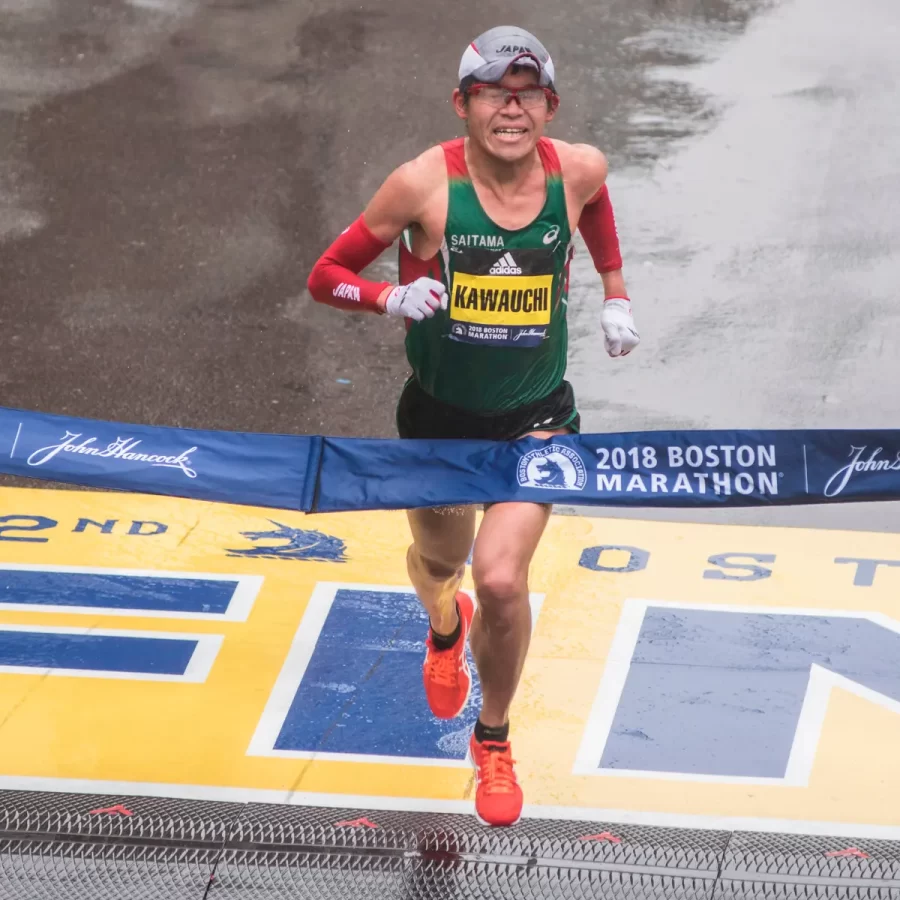Japan is Taking the Marathon World by Storm
September 16, 2022
On April 16, 2018, some of the best runners in the world plodded through the Massachusetts countryside in a deluge of cold, biting rain. As the frontrunners began to wind their way into Boston, a curious sight met the eyes of the spectators. Among the throng of tall and slender Kenyan athletes cutting through the downpour was a diminutive bureaucrat from Tokyo named Yuki Kawauchi. He had no sponsorships, no elite training, and a full-time job, and most surprising of all, he came for a region of the world which had never been known to produce great marathon runners. And yet Yuki Kawauchi was well on his way to winning the Boston Marathon, arguably the most famous marathon in the United States.
However, for those who followed distance running closely, Kawauchi’s victory did not come out of nowhere. He finished 6th in the New York City Marathon in 2015, and finished 9th at the World Championships two years later. All the way back in 2011, he placed 3rd in the Tokyo Marathon, one of the most prestigious races in the sport.
Although one of the most visible examples of the success of Japanese distance running, Kawauchi is far from alone among his countrymen in his excellence over the 26.2-mile distance. Before Kawauchi, Japanese runners had won the Boston Marathon eight times. Perhaps more impressively, at the 2021 Lake Biwa Mainichi Marathon, 42 Japanese runners broke the 2:10 mark. Cut that number in half, and you get the number of American runners who have broken the 2:10 mark ever. This last statistic certainly displays the elite level of Japanese distance running, but it also shows why Japan has historically been overlooked as a marathon powerhouse. Japanese runners have been dominant in domestic marathons like Lake Biwa for decades, often saving their fastest times for races unheard of by many a casual runner from the West. In fact, when Kengo Suzuki ran 2:04:56 at Lake Biwa in 2021, setting the second fastest time for a non-African in marathon history, there was very little international publicity.
It is clear that Japan has been developing some of the world’s best marathoners right under the world’s noses, but a question remains: how are they doing it? At first glance, it would seem that the Japanese lack many of the genetic, geographical, socioeconomic factors which have allowed East Africans to dominate the sport for decades. Most Japanese live in low-altitude areas along the coast, and due to Japan’s modern public transit infrastructure, walking or running long distances is not a necessity. These are not factors that are conducive to a running-crazed society. But this indeed is a good way to describe Japan. Although often eclipsed by baseball, running in Japan is considered by many to be a national sport. Renowned running anthropologist Adharanand Finn once described Japan as the “most running-obsessed culture in the world”. He was probably not that far off.
Japanese running culture revolves around the ekiden, a multi-stage long distance relay race that brings out some of the best collegiate and professional runners in the country. Ekiden goes back to 1917, when a relay race was held from Kyoto to Tokyo to celebrate the anniversary of Tokyo’s inauguration as Japan’s modern capital. Since then, ekiden races have sprung up all over the country. In many places in Japan, ekiden are multi-day events that bring together entire towns to run and celebrate. The most famous ekiden in the country, the Hakone Ekiden, brings together the best collegiate runners from all over Japan, often drawing over a million spectators as it snakes around Tokyo Bay. To give you a better idea of the scale and importance of the Hakone Ekiden, the race has been compared to the Super Bowl, and athletes in the race run times comparable to those of the best American collegiate runners.
The Japanese fascination with running seems to be summed up by the legend of the running monks of Mt. Hiei, a sect of Buddhist monks who are said to run over 23,000 miles over the course of 7 years. According to legend, those who take on the challenge but do not succeed must complete ritual suicide. These legends have of course been highly embellished by over-eager Westerners, but the monks of Mt. Hiei are real, and their extreme pursuit of running perfection gets to the root of why Japanese running culture is so special. For runners like Kengo Suzuki, running is not about international acclaim and multi-million dollar scholarships. It is about being part of a culture of running that spans all ages and backgrounds. And, in a more practical light, who needs to compete in all these elite marathons of the world when you’ve got millions of fans and wall-to-wall television coverage at home.
So, does all this point to a coming wave of Japanese domination in the sport of marathon running? Probably not. East Africans, at least for now, still dominate the sport. Out of the top 100 marathon runners of all time, all but three have come from Kenya, Uganda, Ethiopia, Eritrea, Somalia, or Tanzania. One of those three, of course, is Kengo Suzuki, but for now he stands alone among his countrymen in the all-time marathon rankings. However, we can still learn a lot about the essence of running from Japan. They seem not only to have developed a training regimen capable of producing world-class athletes, but also to have tapped into the heart of why we, as a species, run. Perhaps if we could run like the Japanese, we would learn to love the sport even more.

